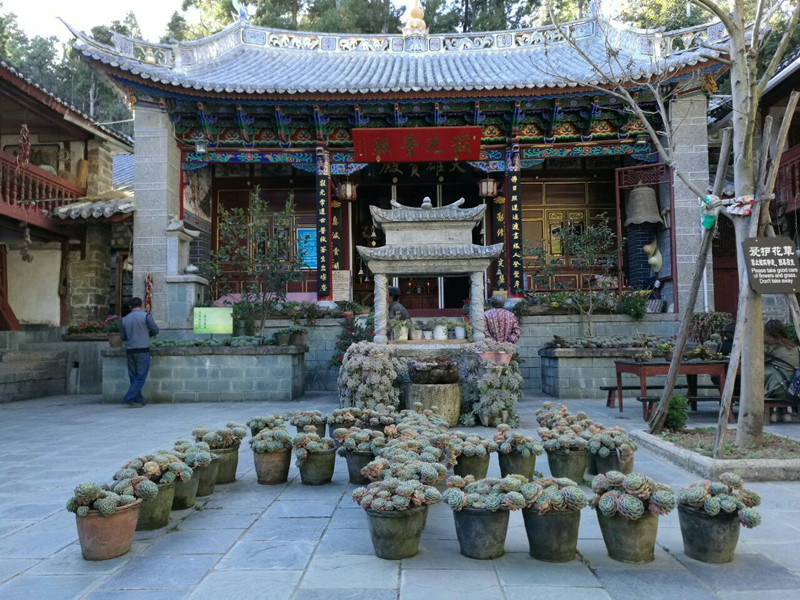Jizhao Nunnery (寂照庵) is a Buddhist nunnery located on the southern foothills of Shengying Peak (圣应峰) in Cangshan Scenic Area (苍山景区), Dali City (大理市), Dali Bai Autonomous Prefecture (大理白族自治州), Yunnan Province (云南省). Founded in the Ming Dynasty, it is named for the phrase “silent illumination” (“感而遂通,寂静照鉴”) and is known as “China’s Most Beautiful Nunnery.” The nunnery is famous for offering succulent plants and fresh flowers instead of traditional incense. After restoration led by Master Miaohui (妙慧法师) in 1982, it formed a unique garden-style layout. Existing buildings follow the Bai (白族) traditional “three courtyards and one screen wall” (三坊一照壁) pattern, including the main hall, side rooms, and gate tower.
History
Jizhao Nunnery was originally built in early Ming Dynasty. In 1919, the monk Lunzhuan from Yaoshi Temple (药师寺) rebuilt the main hall, side rooms, and gate tower, which remain well preserved. In 1982, Master Miaohui led a nun team to comprehensively restore the dilapidated temple and gradually transformed it into a garden-style monastery. In July 2014, the nunnery constructed an unapproved Guest Hall project, which began use in July 2018 but was fined and ordered to rectify in 2019 for encroaching on Cangshan protected land.
Architectural Features

The main structures adopt Bai traditional wooden construction with the “three courtyards and one screen wall” design. The main hall enshrines statues of the Western Three Saints. The left wing serves as the guest hall, the right wing as the Patriarch Hall, and the rear courtyard contains the dining hall and tea room. The nunnery’s name “Jizhao Nunnery” on the gate was inscribed by Tang Jiyao (唐继尧), a former Yunnan governor. The screen wall combines Buddhist bas-reliefs and colorful paintings. The spatial design innovates beyond typical temples, using bamboo blinds, tea tables, and old pottery to create a Zen ambiance.
Religious Philosophy
Master Miaohui proposed the idea “Buddha does not need one incense stick, only a kind heart.” Incense offerings are limited due to three considerations: modern incense production pollutes, fire safety in the Cangshan forest is critical, and Buddhist compassion opposes killing for incense. A small amount of incense offering remains, with incense burners placed outside the main hall in open spaces.
Main Scenic Areas
- Front Garden: Features large hydrangea patches at the entrance, creating a colorful flower belt called “Endless Summer” every June, with rustic pots and fishing boat-inspired flower stands.
- Succulent Corridor: Tens of thousands of succulents arranged along stone steps, using creative containers like pottery and wooden troughs, forming a tiered landscape.
- Zen Backyard: Includes an open-air tea room and koi pond. The tea table is self-service; the pond reflects Cangshan clouds, evoking the poetic image “Heaven’s light and clouds wander together.”
Visitor Information
- From March to July 2025, peak season control applies: opening hours 08:30–15:00; no mountain entry after 3 PM.
- Vegetarian meals are served in shifts; on weekends and lunar 1st and 15th days, meals open earlier at 11:30. Meal fee is 20 yuan/person (free on lunar 1st and 15th).
- Recommended route: Gantong Temple (感通寺) – Jizhao Nunnery – Boluo Temple (波罗寺), approx. 2 hours total.
Cultural Experiences
- Scripture Copying Practice: Midday copying sessions in the backyard tea room, with provided scriptures and writing tools.
- Vegetarian Food Tasting: Seasonal menus use vegetables grown by local farmers; self-service dishware recycling system.
- Plant Education: The greenhouse regularly hosts succulent cultivation lectures and showcases special varieties.

 7 Days GolfingTour
7 Days GolfingTour
 8 Days Group Tour
8 Days Group Tour
 8 Days Yunnan Tour
8 Days Yunnan Tour
 7 Days Shangri La Hiking
7 Days Shangri La Hiking
 11 Days Yunnan Tour
11 Days Yunnan Tour
 6 Days Yuanyang Terraces
6 Days Yuanyang Terraces
 11 Days Yunnan Tour
11 Days Yunnan Tour
 8 Days South Yunnan
8 Days South Yunnan
 7 Days Tea Tour
7 Days Tea Tour
 8 Days Muslim Tour
8 Days Muslim Tour
 12 Days Self-Driving
12 Days Self-Driving
 4 Days Haba Climbing
4 Days Haba Climbing
 Tiger Leaping Gorge
Tiger Leaping Gorge
 Stone Forest
Stone Forest
 Yunnan-Tibet
Yunnan-Tibet
 Hani Rice Terraces
Hani Rice Terraces
 Kunming
Kunming
 Lijiang
Lijiang
 Shangri-la
Shangri-la
 Dali
Dali
 XishuangBanna
XishuangBanna
 Honghe
Honghe
 Kunming
Kunming
 Lijiang
Lijiang
 Shangri-la
Shangri-la
 Yuanyang Rice Terraces
Yuanyang Rice Terraces
 Nujiang
Nujiang
 XishuangBanna
XishuangBanna
 Spring City Golf
Spring City Golf
 Snow Mountain Golf
Snow Mountain Golf
 Stone Mountain Golf
Stone Mountain Golf















